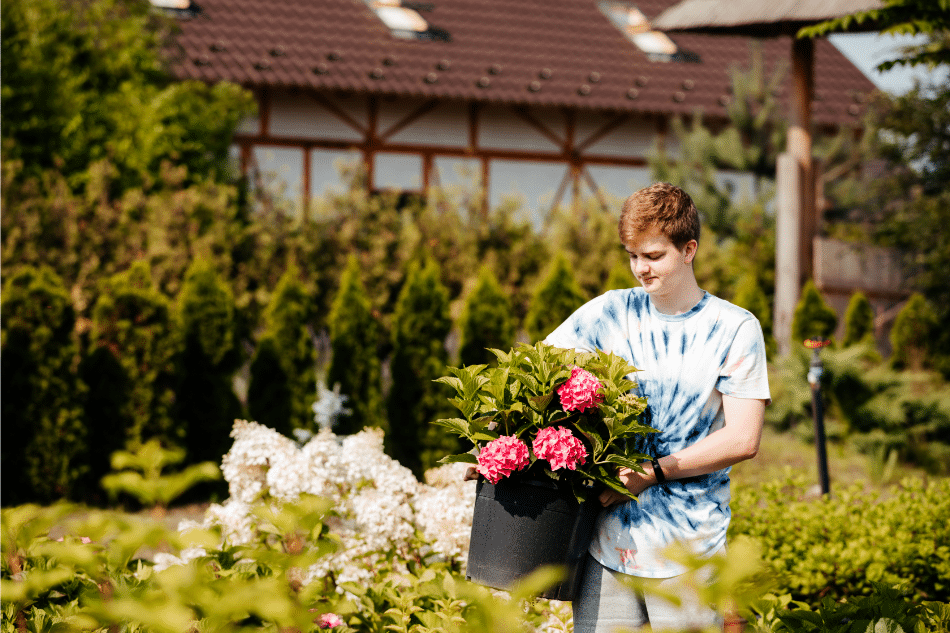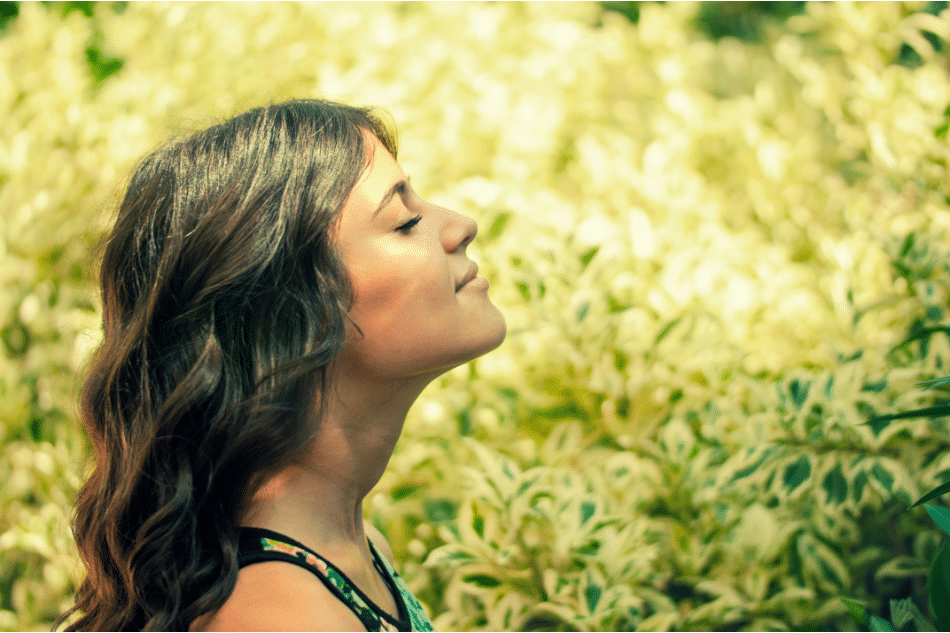Designing a Horticultural Therapy Space for Teens at Home

More teens than ever are experiencing anxiety, depression, and emotional overload, and for many, nature offers a gentle yet powerful form of relief. Research shows that time spent in green spaces can lower cortisol levels, boost mood, and support emotional regulation.¹ That’s why many families are now exploring ways to create a therapy garden at home.
A healing garden doesn’t need to be grand. Even a modest setup like an indoor plant therapy space, a calming backyard garden design, or a DIY healing garden setup on a balcony can become a quiet refuge where teens reconnect with themselves.
To help you understand the benefits of outdoor spaces for teen mental health, and how to design your own horticultural therapy space, this guide explores:
- How home gardening provides emotional support for teens
- How to create a therapy garden at home, complete with layout tips
- Best ways to make use of a youth-focused therapy garden
- How Mission Prep can help with a nature space if you can’t make one at home

Home Gardening for Emotional Support for Teens
For many teens, a garden can become a place for internal regulation, safety, and relief. Research shows that engaging with nature activates the parasympathetic nervous system, lowering physiological stress and improving overall mood.² This isn’t just limited to teenagers, though – gardening seems to prevent mental health problems across all ages.³
Research shows that gardening can also improve our self-expression and self-esteem.⁴ So, in a youth-focused therapy garden, small daily actions can become grounding rituals. Even basic routines like checking soil or watching seedlings sprout can reconnect teens to the present moment, which is crucial when anxiety or other mental health difficulties pull them out of it.
How to Create a Therapy Garden at Home
When you design a therapy garden, it’s important to focus on creating a space where your teen can feel grounded, private, and able to reconnect with their emotions on their terms. Many people assume that a horticultural therapy space is off the cards if you don’t have a garden or a large backyard. But this isn’t the case.
Indoor plant therapy setups can work just as well. Indoor greenery on a shelf, in a corner, or even on the window ledge can provide just enough greenery to ease stress.⁵ What’s more, you don’t need a large backyard or elaborate landscaping to create a therapy garden at home. What matters most is how the space makes your teen feel when they step into it.
Before you even begin to create a therapy garden at home, start by asking your teen a few key questions, like:
- Would you prefer a snug corner or an open space to relax in?
- What type of garden tasks would interest you? Would you like something more intensive like digging, or is watering or sitting still more in line with what you want?
Adolescents respond powerfully to having ownership over their garden space. Studies show that when students take part in planning, planting, and maintaining school gardens, they report higher self‑esteem, a stronger sense of responsibility, and deeper investment in the process.⁶
Use their answers to help guide everything from container choices to plant selection. Once you’ve explored those preferences, it’s time to start shaping the space.
Healing Garden Layout Tips
When you get started, choose an area that doesn’t feel part of the everyday space. Make privacy and comfort two of the main focuses. This could be a shaded corner of the yard, a balcony with potted plants, or even a sunlit spot near a window indoors. Use natural dividers like tall grasses, trellises, or bamboo screens to give the space a sense of privacy.
Incorporate gentle, curved lines instead of rigid grids. Curves naturally slow the body and calm the mind. A small path of stepping stones or a winding trail can help anchor the space and invite slow movement. Add soft surfaces like moss, mulch, or smooth river stones for grounding underfoot. Fairy lights can also bring a space alive at night, so consider decorating with these.
Try to orient a seat toward a focal point. This might be a bird feeder, a flowering shrub, a wind spinner, or a small water feature. Visual still points give the nervous system something to rest on during moments of overwhelm.
Finally, make the space feel personal. Consider including an area where they can arrange their own planters, paint a sign, hang fairy lights, or create a ritual around watering. As we know, giving teens ownership over their space can help it feel more like home.
Best Ways to Use a Youth-Focused Therapy Garden
A youth-focused therapy garden offers more than just a calming environment. It becomes a stage for healthy self-regulation, self-expression, and emotional resilience. To be effective, the space should balance open-ended exploration with simple, predictable routines that foster a sense of safety.
Research on horticultural therapy for adolescents with eating disorders highlights that a structured garden environment with predictable routines, defined roles, and consistent safety cues helps create a sense of psychosocial security alongside personal growth.⁷
Create Meaningful Rituals
Teens thrive when experiences feel symbolic and intentional. Invite them to develop personal rituals like watering a plant each morning as a grounding check-in, writing a worry on a slip of paper and burying it in the soil, or pruning back old growth as a metaphor for letting go. These activities help externalize emotion and transform it into something tactile and manageable.
A case study of a 13‑year‑old participating in a horticultural therapy program in Uruguay showed that creating personal rituals (like decorating a plant pot and caring for snails) led to reduced anxiety, increased self-esteem, and engagement with the process. The teen reported feeling “happy and proud” after each symbolic task, reinforcing her emotional connection to the garden.⁸
Use the Garden for Somatic Reset
A youth-focused therapy garden supports nervous system regulation through sensory grounding. A guide from the American Horticultural Society emphasizes that well-designed sensory gardens engage all eight sensory pathways, including smell, touch, balance, and interoception – and notes this multi-sensory engagement effectively supports emotional regulation and sensory integration in children and teens.⁹
Teach your teen the power of walking barefoot on soft green grass. Get them to rub lavender between their fingers and smell the fragrance. Welcome them to sit in silence and enjoy the natural sounds and textures of their environment. These embodied practices calm their stress response system and help teens reconnect with their physical bodies, which is especially important for teens who are struggling with their mental health.
Make It a Safe Space for Expression
Not every teen wants to talk. But many will engage with planting, rearranging, or journaling while surrounded by plants. In fact, horticultural therapy has even proven effective for non-verbal teens on the autism spectrum because it offers non-verbal engagement.¹⁰
A garden can act as a co-regulator, like an emotionally neutral third space where teens don’t feel pressured to perform or explain. Leave notebooks, prompts, or art materials nearby to offer nonverbal outlets for expression.
Link Garden Time With Emotional Check-Ins
Over time, try to pair garden activities with light emotional reflection. Ask questions like:
- “What feels new today?”
- “What’s growing that you didn’t expect?”
These questions can gently build insight. This helps teens associate emotional self-awareness with calming routines rather than conflict or overwhelm.
How Mission Prep Can Help with a Nature Space for Mental Health
Not every family has access to a backyard, or the time or tools to create a DIY healing garden setup from scratch. But that doesn’t mean your teen can’t experience the benefits of nature-based mental health support. Mission Prep integrates home-based horticultural therapy strategies into its personalized care plans, offering solutions that fit your environment, schedule, and teen’s unique emotional needs.
For families without outdoor space, Mission Prep can help link you to resources where your teen can participate in group teen gardening therapy away from home. Depending on the situation, we might recommend community garden programs or assist with youth garden space planning in local shared spaces.
Most importantly, we help your teen develop a personal connection to nature that goes beyond location. Whether through calming backyard garden design, balcony herbs, or symbolic plant care rituals, our clinicians understand how to build a natural space for mental health that drives ownership, regulation, and daily relief.

Reach Out to Mission Prep for Advice on Home-Based Horticultural Therapy
Whether you’re curious about how to build a sensory garden, looking for therapeutic garden ideas for teens, or needing guidance on healing garden layout tips, Mission Prep can help.
Our team specializes in youth-focused therapy garden solutions that fit real families and real constraints. We offer tailored support for home gardening for emotional support, help with indoor plant selection, and practical ideas for setting up a backyard therapy area for teens that aligns with their emotional and sensory needs.
Even if you’re starting small, you don’t have to figure it out alone. Reach out today for individualized advice on how to create a therapy garden at home, and find out more about other therapy options that might complement a nature therapy approach.
References
- Roe, J. J., Thompson, C. W., Aspinall, P. A., Brewer, M. J., Duff, E. I., Miller, D., Mitchell, R., & Clow, A. (2013). Green space and stress: Evidence from cortisol measures in deprived urban communities. International Journal of Environmental Research and Public Health, 10(9), 4086–4103. https://pmc.ncbi.nlm.nih.gov/articles/PMC3799530/
- Jo, H., Song, C., & Miyazaki, Y. (2019). Physiological benefits of viewing nature: A systematic review of indoor experiments. International Journal of Environmental Research and Public Health, 16(23), 4739. https://pmc.ncbi.nlm.nih.gov/articles/PMC6926748/
- Ainamani, H. E., Gumisiriza, N., Bamwerinde, W. M., & Rukundo, G. Z. (2022). Gardening activity and its relationship to mental health: Understudied and untapped in low- and middle-income countries. Preventive Medicine Reports, 29, 101946. https://pmc.ncbi.nlm.nih.gov/articles/PMC9389296/
- Xiaoyi, L., Hassan, A., Tao, J., & Deshun, Z. (2024). Psychological and physiological benefits of horticultural therapy for Chinese older adults. Hong Kong Journal of Occupational Therapy, 37(2), 83–90. https://pmc.ncbi.nlm.nih.gov/articles/PMC11556247
- Bringslimark, T., Hartig, T., & Patil, G. G. (2009). The psychological benefits of indoor plants: A critical review of the experimental literature. Journal of Environmental Psychology, 29(4), 422–433. https://www.sciencedirect.com/science/article/abs/pii/S0272494409000413
- Cornell University. (n.d.). Key findings. Cornell.edu. Retrieved July 18, 2025, from https://gardening.cals.cornell.edu/lessons/program-tools/benefits-and-research/key-findings
- Curzio, O., Billeci, L., Belmonti, V., Colantonio, S., Cotrozzi, L., De Pasquale, C. F., Morales, M. A., Nali, C., Pascali, M. A., Venturi, F., Tonacci, A., Zannoni, N., & Maestro, S. (2022). Horticultural therapy may reduce psychological and physiological stress in adolescents with anorexia nervosa: A pilot study. Nutrients, 14(24), 5198. https://pmc.ncbi.nlm.nih.gov/articles/PMC9786778/
- Bonazzi, D. S.-R. (2023, June 14). Case study: Horticultural therapy with a teenager in Uruguay. Horticultural Therapy Institute. https://www.htinstitute.org/blog/case-study-horticultural-therapy-with-a-teenager-in-uruguay
- American Horticultural Society. (n.d.). AHS youth sensory gardening manual. Ahsgardening.org. Retrieved July 18, 2025, from https://ahsgardening.org/wp-content/uploads/2025/05/AHS-Youth-Sensory-Gardening-Manual.pdf
- Nevil, W. S., & Beela, G. K. (2023). Impact of horticultural therapy in social intelligence of people with autism spectrum disorder. International Journal of Autism, 3(1), 6–13. https://www.rehabilitationjournals.com/autism-journal/article/19/3-1-2-518.pdf

















